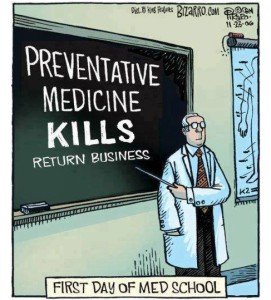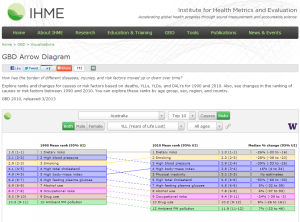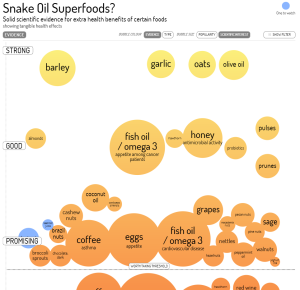..or why managing diabetes doesn’t fit with how doctors have been taught, and therefore generally like, to treat patients >>> we need a radically new approach not involving doctors, busy doing other things – see Iora Health post re. health coaches.
The good news: lifestyle change for the obese or those with prediabetes may have lower progression to diabetes
http://archinte.jamanetwork.com/article.aspx?articleid=1485081
The average news: childhood obesity is plateauing [PN: ??from a scandalously high base]
http://www.nytimes.com/2012/12/11/health/childhood-obesity-drops-in-new-york-and-philadelphia.html?_r=0
The bad news: Intensive lifestyle change for diabetics did not reduce the risk of stroke or heart attack, even though these patients were able to lose weight, improve their overall quality of life, take fewer medications and even decrease costs.
Lifestyle changes — diet and exercise — require huge and ongoing investment efforts for patients; we’d like to think it pays off for the big-ticket clinical outcomes. Hopefully future studies will show benefits.
OCTOBER 17, 2013, 3:43 PM
The Challenge of Diabetes for Doctor and Patient
By DANIELLE OFRI, M.D.My patient was miserable — parched with thirst, exhausted and jumping up to go to the bathroom every few minutes. His vision was blurry and he’d been losing weight the last few weeks, despite eating voraciously. I’d only just met him, but I was able to diagnose diabetes in about a minute. What was unusual was that this was a scheduled office visit; usually, patients with such overwhelming symptoms are the provenance of emergency departments and urgent care centers.
A quick shot of insulin and five glasses of water and my patient felt like a new man, with no need to go to the E.R. But now, of course, the hard work would begin. A new diagnosis of diabetes is an enormous undertaking — lots to explain, major life changes to contemplate, myths to dispel, consultations with a nutritionist and a diabetes nurse.
Two days later I had another new patient for a scheduled visit — thirsty, tired, losing weight, eating and drinking like mad, eyes so blurred he could hardly see. We’d barely gotten past the introductions before I’d made another new diagnosis of diabetes. Another shot of insulin, another five glasses of water, and then the plunge into the thicket of diabetes education.
Most of my regular office visits with diabetic patients — even newly diagnosed patients — don’t involve such dramatic presentations. More often the disease is found when we screen patients who have risk factors like obesity or a family history of the disease, or who have commonly co-occurring illnesses like hypertension, heart disease or elevated cholesterol.
These two patients highlighted the outsized role that diabetes plays in the primary care setting. The tidal wave of diabetes over the last two decades has made it one of the most common diseases that internists and family doctors treat. Right now feels like a good-news-bad-news time on the diabetes front, which in a general medical clinic can sometimes feel like the only front there is.
The good news is that childhood obesity rates have begun to inch downward in some cities, including among poor children, the first positive sign in the obesity epidemic in years. Obese children are potential future diabetic patients, so even incremental progress is a public health victory to celebrate.
Also good news is a study in which adults with obesity and pre-diabetes were able to lose weight with sensible lifestyle changes and coaching. This took place in a primary care setting, not a research setting, so this also suggests that we might be able to bend the curve of new diagnoses of diabetes.
But there’s also bad news. Intensive lifestyle changes for patients with diabetes, disappointingly, did not reduce the risk of stroke or heart attack, even though these patients were able to lose weight, improve their overall quality of life, take fewer medications and even decrease costs. Lifestyle changes — diet and exercise — require huge and ongoing investment efforts for patients; we’d like to think it pays off for the big-ticket clinical outcomes. Hopefully future studies will show benefits.
Even with all the research and new treatments available, combating diabetes can feel like a Sisyphean task. The bizarre contradiction of junk food being cheaper than healthy food, combined with a bombardment of advertising — especially toward children — make it a challenge even for motivated people to eat healthfully. Sugary drinks in monster-size containers abound. And our fixation with screens large and small keeps us increasingly sedentary.
But even with all the uphill challenges, there are successes, even if not perfect ones. Both of my patients who came to my office with florid diabetes that week have improved. Perhaps it was the concreteness of their symptoms that motivated them, but they have both made steady progress getting their diabetes under control.
Over the past few months they’ve been eating more moderately, and exercising more regularly. We’ve been calibrating their medications so that their blood sugars have left the stratospheric levels and are now only moderately elevated. Medication side effects, cost of glucose meter supplies, real-life logistics, and concomitant issues of blood pressure and cholesterol control have made it a challenge to get to normal. We’d still be dinged as “failures” in the quality-measures department for not achieving the recommended clinical goals, but both patients feel vastly better and are much healthier now.
So there’s bad news and good news. But the real news for these two patients – and for many, many more like them — is that diabetes is a marathon, not a sprint. Although there have been a flurry of life changes right now, diabetes is something they will live with for the rest of their lives. They will always have to be cognizant of what they eat. They will have to keep track of medications, glucose levels, carbohydrate intake, doctors’ appointments, exercise, and weight. They will have to be on the lookout for the many complications that diabetes can bring. This of course is not news to anyone who has diabetes or treats diabetes, but for these two patients this was news.
Now, we gear up for the long haul, the messy, complicated, occasionally gratifying business of living with a lifelong chronic illness.
Dr. Danielle Ofri’s newest book is “What Doctors Feel: How Emotions Affect the Practice of Medicine.” She is an associate professor of medicine at NYU School of Medicine and editor in chief of the Bellevue Literary Review.
http://well.blogs.nytimes.com/2013/10/17/the-challenge-of-diabetes-for-doctor-and-patient




![WP_20131103_010[1]](http://blog.panicola.com/wp-content/uploads/2013/11/WP_20131103_0101-300x168.jpg)